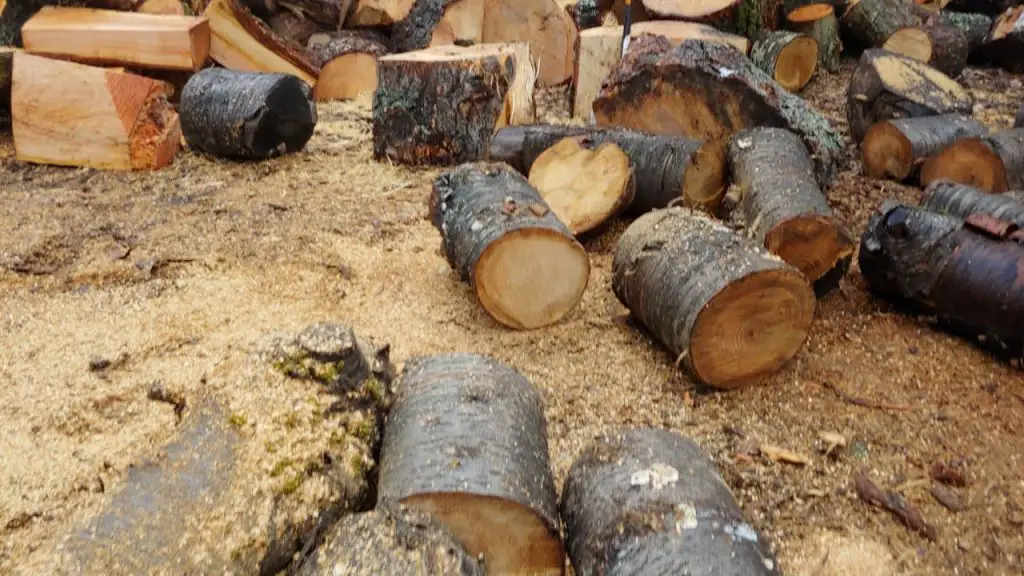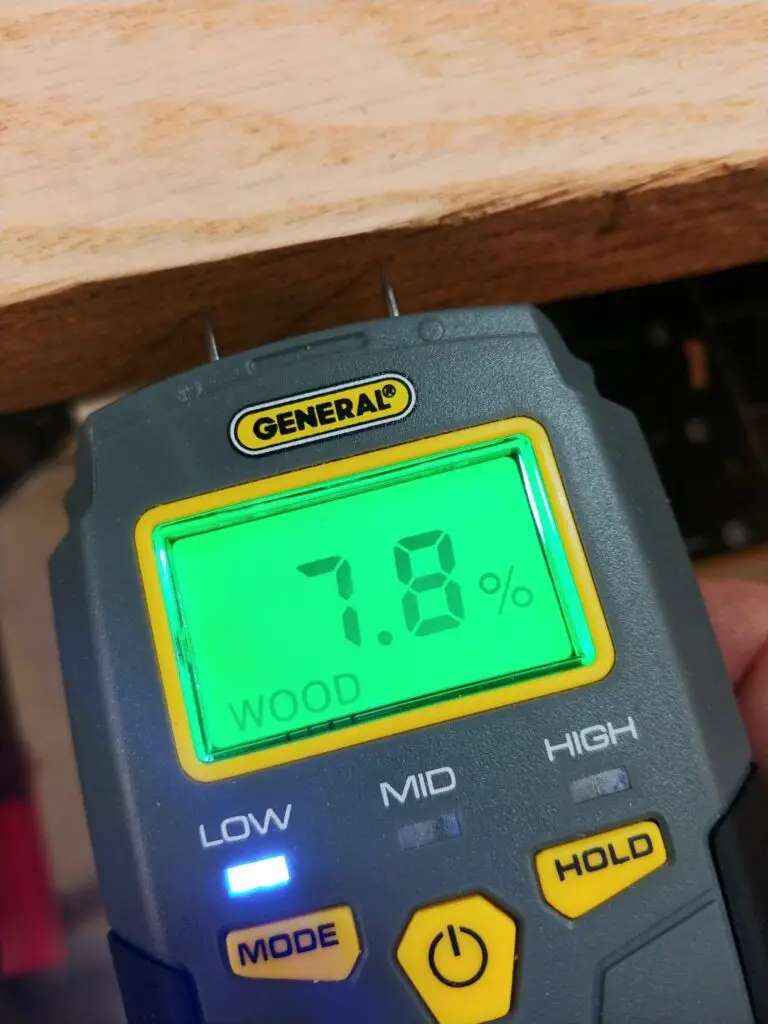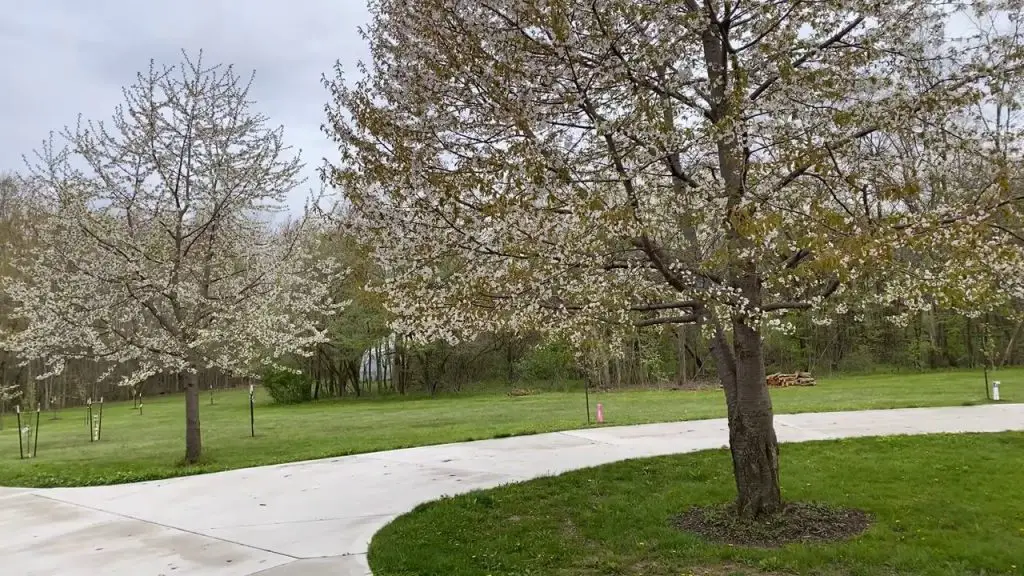Cherry is good firewood that is easy to split, has low smoke production, has a nice fragrance, and produces few sparks.
However, some say to leave the cherry behind because of its low heat production.
So, is cherry good firewood?
Overall, cherry is good firewood to add to your pile for the winter. While it may not be firewood that you go out and seek, if it’s available, it is definitely worth using.
Table of Contents
Summary
- BTU: 20.4 million BTUs per cord
- Weight: 2928 lbs per dry cord
- Seasoning Time: 8-10 months
- Splitting: Easy
- Smoke: Low
- Sparks: Few
- Smell: Excellent
Cherry trees are hardwood trees that grow in USDA zones 4-7. You can find many cherry trees being used for landscaping because of their beautiful spring blossoms.
Cherry has many great characteristics for firewood with the exception of a lower BTU compared to other hardwoods.

Heat Production
Comparatively, cherry firewood does not produce as much heat as other common hard firewoods such as oak or maple. This is really where cherry falls flat as firewood.
Cherry produces 20.4 million BTUs per cord. Cherry is nice to use to start fires because it lights easily and creates a quick, hot fire.
A cord of firewood is 128 cubic feet, cut into 16-inch lengths, and stacked into three 4×8 rows.
Smoke Production
Cherry gives off a low amount of smoke when seasoned properly.
Of course, burning green cherry will produce billows of smoke that will be unbearable to be around. It is always best to burn only seasoned wood.
Cherry wood is often used for smoking meats, cheeses, and fish and is an extremely popular incense.
Along with low smoke, cherry also gives off very few sparks, making it a safe wood to burn indoors. Of course, always use a screen or glass doors with your indoor fire.
You’ll also get good-quality coals when burning cherry firewood. While it doesn’t last as good as black locust, cherry coals will bring you through the entire night if need be.
Of course, all of these characteristics are shown when cherry wood is dry and seasoned properly. If you attempt to burn green cherrywood, you will find that it will smoke heavily, and will not create any coals.
Seasoning Time
Seasoned wood has a moisture content of less than 20 percent. Firewood with a higher moisture content than 20 percent is harder to light and frustrating to burn. It also produces more smoke and creosotes buildup.
Depending on the climate in which you live, cherry firewood will take 6-8 months to fully season. For a hardwood, this is very fast and yet another benefit of cherry firewood.
If you have cherrywood available in your area and you need to beef up your winter’s supply quickly, cherry is a great addition to your woodpile.
I personally recommend this General Tools Moisture Meter. It allows you to accurately gauge how wet your firewood is and whether it is sufficiently seasoned. Over time you can also see how quickly the moisture is dropping and how much longer you need to keep your firewood dropping until it is seasoned and ready to burn.
Press the sharp pins into the wood and you will quickly see the readout show the moisture ranging from 5% to 50%. It also has a Low/Mid/High indication depending on whether the wood is dry enough, so you don’t need to remember the actual values.

Burning Smell
Some people seek out cherry firewood for its smell alone because cherry firewood has a pleasant, fruity smell when burned.
The scent of cherry firewood is sweet and long-lasting. Burning cherry inside in your fireplace can lead to its pleasant aroma being around for up to 2 weeks!
Creosote Buildup
Creosote is a dark brown tar deposited from wood smoke that can build up on the insides of your chimney walls. It contains tiny unburned particles of wood and sap found in smoke. Creosote can be extremely dangerous because of how flammable creosote is and will quickly start a chimney fire. Firewood with higher levels of sap will create more creosote.
As a hardwood, cherry has low sap content and so when seasoned properly, it will produce low amounts of creosote.
Splitting
Splitting cherry is fairly easy with either a splitting axe, splitting maul or hydraulic wood splitter.
Many enjoy splitting cherry firewood because you can split one round with one strike. Cherry firewood should be split when green, as this makes it easier to split.
Be wary, though, because some cherry trees can grow corkscrew, primarily if the cherry tree was used for landscaping and pruned harshly. This will be more difficult to split with an axe.
Different Types/Species
Cherry trees are extremely sought-after trees for multiple industries.
Cherry trees offer beautiful white, pink, and purple spring blossoms for landscaping. Cherry trees are easy to prune and keep trim, also making them desirable for gardens.
Cherry trees are also popular in the lumber industry because of their red-brown interior and beautiful grain pattern. You can find cherry furniture at a premium price and will often see it used for cabinets and flooring.
You’ll also find cherry wood used for incense, meat smoking, and other fragrant uses.
Cherry trees bloom in the spring from late March to late April. You’ll find most cherry trees for landscaping, the black cherry tree being the most common variety.
If grown in male/female pairs, the cherry tree will produce cherries, which ripen throughout the summer.
Cherry trees are part of the genus Prunus, and there are around 430 different species within this genus. Throughout North America, Europe, and Asia, cherry trees are native to northern climates.
Black cherry trees are most commonly found and are typically the species of cherry tree referred to when speaking in firewood terms.
You can find black cherry trees throughout the Midwest and the eastern United States. The tree produces white flowers in the spring. Mature black cherry trees have dark and scaly bark that flips on the edges. The older they get, the darker the bark will be. They grow to be 50-60 ft tall and prefer full sun.
The leaves of black cherry trees are simple, shiny, and oval-shaped. They are dark green and appear to have a waxy glaze on them. What is unique to these leaves is that the underside of the leaves has fuzzy-rust colored hairs.
Black cherry trees get their name from their very distinct dark red to almost black fruit. Cherries ripen from late August to September.

Other cherry trees commonly found
- Cherry Blossom or Japanese Cherry Tree – located in New York and California; cherry blossom trees have distinguishable red-brown bark and dark green leaves. The tree is magnificent in the spring with a show of pink blossoms.
- Sour Cherry Tree – found in most of the United States and into British Columbia, the sour cherry tree has dark green serrated leaves and produces white flowers in the spring. The sour cherry tree prefers cooler, humid climates.
- Sweet Cherry Tree – You can find sweet cherry trees throughout the United States, with the exception of the midwest and British Columbia. The characteristics of sweet cherry trees almost mimic sour cherry trees except for preferring warmer, full sunlight and well-drained soil.
- Bing Cherry – Bing cherry trees can grow throughout the United States but prefer a colder climate. They produce white flowers and require full sunlight.
- Yoshino Cherry Tree – Native to Japan but also introduced to the United States, Yoshino cherry trees are the famous cherry trees are in Washington D.C. as a gift from Japan. They put on quite the show in the spring with their beautiful pale pink flowers.
- Stella Cherry Tree – The Stella cherry tree is particular and likes to be in temperatures below 45 degrees Fahrenheit. The Stella cherry tree produces a very popular type of heart-shaped cherry.
- Autumnalis Cherry Tree – This tree likes a moderate climate that does not reach too hot or cold temperatures. You can often see Autumnalis cherry trees used for landscaping to create shade.
- Montmorency Cherry Tree – Found only in northern regions, the Montmorency cherry tree produces white flowers and delicious tart cherries. These cherries often end up in baked goods such as pies, jams, and preserves.
- Kwanzan Cherry – Found mostly in Southern US, the Kwanzan cherry tree is mainly grown for its massive flower show. The Kwanzan cherry tree does not produce fruit.
Other cherry trees of mention:
- Takesimensis Cherry
- Weeping Higan Cherry
- Sargent Cherry
- Shirofugen Cherry
- Okame Cherry
- Chokecherry
Comparison to Other Woods
Here, I’ve taken some of the most popular firewoods to burn indoors and compared them to Alder firewood using Utah State University’s findings on Wood Heating
| Firewood | BTUs | Ease of Splitting | Coals | Overall Quality |
| Green Ash | 20.0 | Easy | Good | Excellent |
| Maple | 25.5 | Easy | Excellent | Excellent |
| Bur Oak | 26.2 | Easy | Good | Excellent |
| Cherry | 20.4 | Easy | Excellent | Good |
Comparatively, cherry has great characteristics of reliable and easy-to-use firewood. As mentioned before, cherry falls in the low to medium range for hardwood BTU, which is the only thing holding it back from being overall excellent firewood.
FAQs
Can you burn cherry firewood in a firepit or while camping?
Yes! Some people love burning cherry in their firepit because of its low smoke production and nice smell. This is particularly nice for sitting around a fire and roasting marshmallows.
Is cherry firewood safe to burn in a fireplace or wood stove?
Yes, cherry firewood is safe to burn in a fireplace and/or a wood stove once seasoned. It is not a good idea to burn any green firewood indoors because of excessive smoke and sparking. Ensure your firewood is seasoned correctly before burning it indoors.
How much does cherry firewood cost to buy?
Cherry firewood will cost around $300 per cord, depending on location and availability.
Final Thoughts
Cherry is a beautiful tree inside and out. During the spring, cherry trees will enchant you with their incredible blooming flowers. Once felled, cherry is a valuable wood for carpenters and has endless uses. One of which is being firewood that checks off as exceptional in many boxes.
While cherry firewood might not be your #1 choice of firewood for the winter, it is a pleasant experience burning cherry any time of year. Cherry has become a favorite for some because it is easy to split, has a fast seasoning time, and smells great while burning. Others tend to pass over cherry because of its low heat production.
If you have cherry available, especially if it is free because of a fallen tree or someone is giving it away, absolutely take that opportunity to add cherry firewood to your pile.
